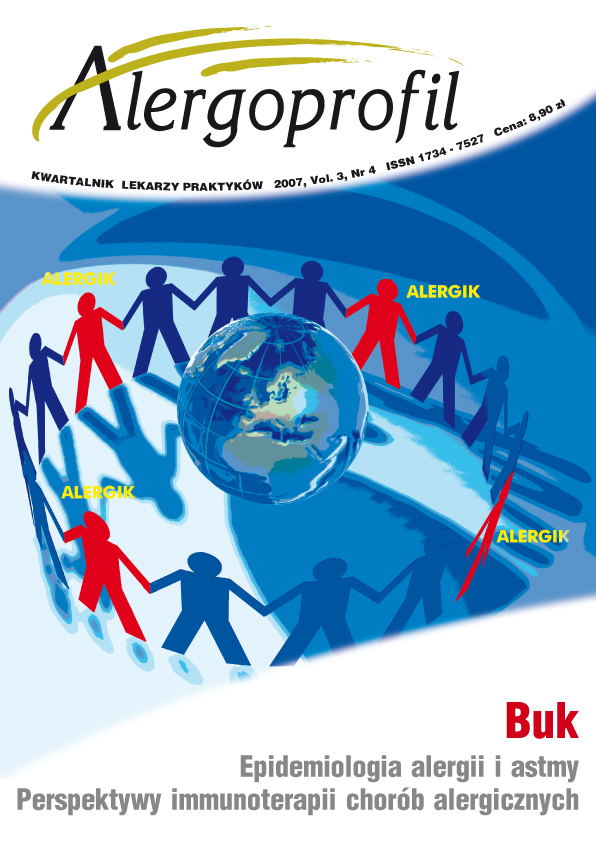Birch pollen in the selected Polish cities – 2007
Main Article Content
Abstract
The aim of the study was to analyse the pollen seasons of birch in the cities of Szczecin, Wroclaw, Krakow, Lublin, Warsaw, Sosnowiec and Bydgoszcz in 2007. Measurements were performed by the volumetric method (Burkard and Lanzoni 2000 pollen sampler). Pollen season was defined as the period in which 98% of the annual total catch occurred. The start of the season was also determined by the SUM 75 method. The pollen season of birch started first in Szczecin on the 1st of April and in the other cities it started during the next several days. The highest airborne concentration of 2762 pollen grains × m-3 was noted in Lublin on the 15th of April.
Downloads
Article Details
Copyright: © Medical Education sp. z o.o. This is an Open Access article distributed under the terms of the Attribution-NonCommercial 4.0 International (CC BY-NC 4.0). License (https://creativecommons.org/licenses/by-nc/4.0/), allowing third parties to copy and redistribute the material in any medium or format and to remix, transform, and build upon the material, provided the original work is properly cited and states its license.
Address reprint requests to: Medical Education, Marcin Kuźma (marcin.kuzma@mededu.pl)
References
2. Emberlin J., Detandt M., Gehring R., Jaeger S., Nolard N., Rantio-Lehtimaki A.: Responses in the start of Betula (birch) pollen season to recent changes in spring temperatures across Europe. Int. J. Biometeorol. 2002; 46: 159-170.
3. Jentys-Szaferowa J.: Morfologia, systematyka i zmienność. W: Białobok S. (ed.), Brzozy. PWN 197, 25-64.
4. John-Schmid B., Radakovics A., Lottkopf D., Scheurer S., Vieths S., Ebner Ch., Bohle B.: Bet v 1142-156 is the dominant T-cell epitope of major birch pollen allergen and important for cross-reactivity with Bet v 1-related ford allergens. J. Allergy Clin. Immunol 2005; 116: 213-219.
5. Kasprzyk I.: Flowering phenology and airborne pollen grains of chosen three taxa in Rzeszów (SE Poland). Aerobiologia 2003; 19: 113-120.
6. Mandrioli P., Comtois P., Dominguez E., Galan C., Isard S., Syzdek L.: Sampling: Principles and Techniques. In: Mandrioli P., Comtois P., Levizzani V. (ed.), Methods in Aerobiology. Pitagora Editrice Bologna, Bologna 1998; 47-112.
7. Neudecker P., Schweimer K., Nerkamp J., Scheurer S., Vieths S., Sticht H., Rosch P.: Allergic Cross-reactivity Made Visible. J. Biol. Chem. 2001; 276:22756-22763.
8. Rapiejko P., Lipiec A., Wojdas A., Jurkiewicz D.: Threshold pollen concentration necessary to evoke allergic symptoms. Int. Rev. Allergol. Clin. 2004; 10 (3):91-94.
9. Rodkiewicz B., Śnieżko R., Fryk B., Niewęgłowska B., Tchórzewska D.: Embriologia Angiospermae Rozwojowa i Eksperymentalna. Lublin, wydawnictwo UMCS 1996.
10. Szczepanek K.: Pollen calendar for Cracow (Sout. Poland) 1982-1991. Aerobiologia 1994; 10/1: 65-75.
11. Weryszko-Chmielewska E., Puc M., Rapiejko P.: Comparative analysis of pollen counts of Corylus, Alnus and Betula in Szczecin, Warsaw and Lublin (2000-2001). Ann Agric Environ Med 2001; 8:235-240.
12. Wihl J. A., Ipsen B., Nuchel P. B., Munch E. P., Janniche E. P., Lovenstein H.: Immunotherapy with partially purified and standardized tree pollen extracts. Allergy 1998; 43:363-369.

